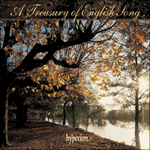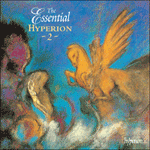
Welcome to Hyperion Records, an independent British classical label devoted to presenting high-quality recordings of music of all styles and from all periods from the twelfth century to the twenty-first.
Hyperion offers both CDs, and downloads in a number of formats. The site is also available in several languages.
Please use the dropdown buttons to set your preferred options, or use the checkbox to accept the defaults.

Central to A Fire of Turf are the passing seasons of the year, the changing winds, the supremacy of nature and (in true Hardyesque fashion) its oblivion to man. On a human level this is paralleled in the phases of a man’s life, which, with the rapid passing of time (symbolised in the blowing of the winds), sees our protagonist dream of his past existence through childhood, youth, love and old age, from summer’s energy to winter’s reflection, memories kept alive by the heat and glow of the turf. This lies at the heart of the first song, A Fire of Turf, a broad lyrical exposition, muscular yet tender in sentiment.
The second song, The Chapel on the Hill, is one of Stanford’s gentle modal meditations infused with elements of traditional Irish melody. At first we are filled with the impressions of pastoral childhood innocence, of religious piety and communal security, but all this is quietly unsettled by sexual awakening as, replete with tierce de Picardie, ‘the noonday sunshine [is] caught in Mary Connor’s hair’.
Having established a tonal base of D for the first two songs, Stanford subtly lifts the third song, Cowslip Time, up a semitone to E flat major, a shift underpinning the optimistic, new-found warmth of spring and the symbolism of perennial fertility.
In the relative minor, Scared provides an entertaining foil with its melodrama, ghosts and ‘things that go bump in the night’, though aside from its humorous badinage it obliquely suggests the uncertainties and unexpected turns that life may bring.
As a counterpart to Cowslip Time, the melodically euphonious Blackberry Time captures a day of arduous travelling, of collecting blackberries in the country and selling them in the town. As with so many of Stanford’s strophic songs, an ostensibly simple design is, in detail, highly sophisticated. In this instance the composer suspends the entire structure above a dominant pedal (bringing resolution only in the final bar), thus equating the sense of musical continuity with the central theme of ceaseless and fatiguing travel. There is also a subtle matrix of harmonic variegation, notably in the augmented fourth verse (‘We traipis round from door to door’) and at the climax of the last (‘Och! sure the thought of home’) which, as part of a rich, fertile diatonic idiom, must have been influential on the emerging Ivor Gurney.
In The Fair there is a sense of gaiety and prosperity as our couple arrive in their ‘fine new ass-and-cart’ before the people ‘kilt with envy’. Elements of modality, notably the potent Dorian E minor that obliquely begins the song and colours the penultimate phrase of each verse (‘with pride and joy of heart’), lend a spirit of folksong to the ditty, and there is much in common with Stanford’s well-known folksong arrangement, Trottin’ to the Fair, in the distinctive subdominant close to all four verses, leaving the piano to provide the cadence.
The final song of the cycle, The West Wind, is by far the most discursive and substantial composition. Cast in three sections, it depicts the wild wind from the Atlantic as it hurls itself against the landscape and our protagonist’s plea for rest. This turbulence (a metaphor for life’s eternal struggle) is vividly imparted in the central paragraph which embarks from D minor (the tonal centre of the first two songs). Departure from D, however, is marked with conspicuous rapidity as the tonality shifts chromatically upwards, a tendency absent from the rest of the cycle. Framing this stormy passage are two sections of more lyrical inclination in F major, the first contemplating the peace of a tranquil autumn, and the second a gentle postlude full of reflection and release, as well as a passing valedictory reference to the opening song.
from notes by Jeremy Dibble © 2000
 A Treasury of English Song A Treasury of English Song |
 The Essential Hyperion, Vol. 2 The Essential Hyperion, Vol. 2'More than just a highlight sampler. This is a classy collection, brought together with a great deal of care and attention to musical programming seldom found in this kind of CD … A stocking-filler any music lover would appreciate' (Scotland ...» More |

